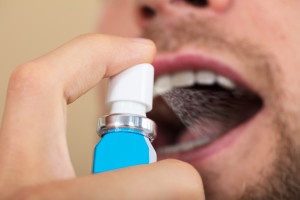 If you’re concerned that your breath isn’t as sweet as a rose, take heart. Halitosis (otherwise known as bad breath) is very common. In fact, this affliction is estimated to affect as many as 1 in 4 people around the world. There are many causes of bad breath, including poor oral hygiene, leftover food particles in the mouth, smoking, alcohol consumption, a dry mouth or the buildup of ketones in the body. Fortunately, there are just as many ways to treat this unpleasant condition.
If you’re concerned that your breath isn’t as sweet as a rose, take heart. Halitosis (otherwise known as bad breath) is very common. In fact, this affliction is estimated to affect as many as 1 in 4 people around the world. There are many causes of bad breath, including poor oral hygiene, leftover food particles in the mouth, smoking, alcohol consumption, a dry mouth or the buildup of ketones in the body. Fortunately, there are just as many ways to treat this unpleasant condition.
Here’s a closer look at breath freshening gum, mints, rinses and sprays, and the best methods for getting rid of bad breath.
Getting to the Root of the Problem — What is Causing Bad Breath?
In trying to choose the best treatment for bad breath, it is helpful to know what’s causing it. When bacteria break down in the mouth, it produces sulfur compounds which can cause halitosis. The tongue is particularly susceptible to this. The mouth has a warm and moist environment, the perfect setting for bacteria to thrive. This is why dental hygiene is so important. Other causes may be an infection, draining or infected sinuses, gastroesophageal reflux disease (GERD), acid reflux, a systemic disease or perhaps even the medication for one of these conditions. Whether it’s a systemic problem or a local issue makes a difference. Something systemic may require a long-term solution, whereas temporarily masking the odor may be enough for a localized problem.
The Two Categories of Breath Fresheners
When looking for a breath freshener, you’ll have a choice of products that will mask the odor for about 20 minutes (most over-the-counter mints, gums and mouthwashes), and more powerful products that contain antibacterial or antimicrobial agents to get to the source of the stink.
Gum – Chewing on gum, while it can be an annoying habit if done in excess (not to mention irritating the temporomandibular joint), has a few advantages for ridding the mouth of bad breath, at least temporarily. For one, it’s sticky, so it helps to remove food from the teeth. Also, chewing gum increases the flow of saliva, and saliva remineralizes the teeth, strengthening the enamel. If you chew gum to freshen your mouth, use only sugar-free gum and do so in moderation.
Sugar-free mints – This is a temporary fix, but it may be enough if you just need to freshen your breath before a job interview, a date or some other social activity. Xylitol, a sugar substitute found in some mints, has cariostatic properties (the ability to inhibit dental decay). In addition, as with gum, the added saliva generated from sucking on a mint will help to neutralize acids in the mouth.
Sprays – It is a good idea to avoid breath freshener sprays. Why? Because most contain alcohol, and alcohol dries out the mouth. When dry, the mouth may become a haven for bacteria, which can cause bad breath. If you must use a breath spray, try to only use it occasionally and find a brand that doesn’t contain alcohol.
Mouth Rinses (Preventative) – Onto more serious products for more long-term solutions. For prevention, there are traditional choices such as Listerine, which blends alcohol plus essential oils like menthol and eucalyptol. This product, and generic versions that call themselves “antiseptics,” are approved by the American Dental Association (ADA). There are versions that do not contain alcohol, though these do not carry the same ADA approval seal. However, since alcohol can cause a dry mouth, some may prefer using an alcohol-free rinse.
Mouth Rinses (Therapeutic) – If the halitosis is the symptom of serious gum disease, chlorhexidine gluconate is a highly recommended treatment. It’s available by prescription only. Used in a concentration of .12 percent maximum, it effectively disrupts plaque’s cellular wall and kills bacteria before it can take hold and organize itself into biofilm. Chlorhexidine works for up to eight hours and can deeply penetrate gum tissue. Rinses with stannous fluoride are also effective treatment; however, it gets deposited onto the teeth.
Especially in the case of long-term halitosis, it is recommended that you see your dentist. They’ll be able to track down the cause, determine if it’s local or systemic and prescribe the best treatment.







Leave a Reply